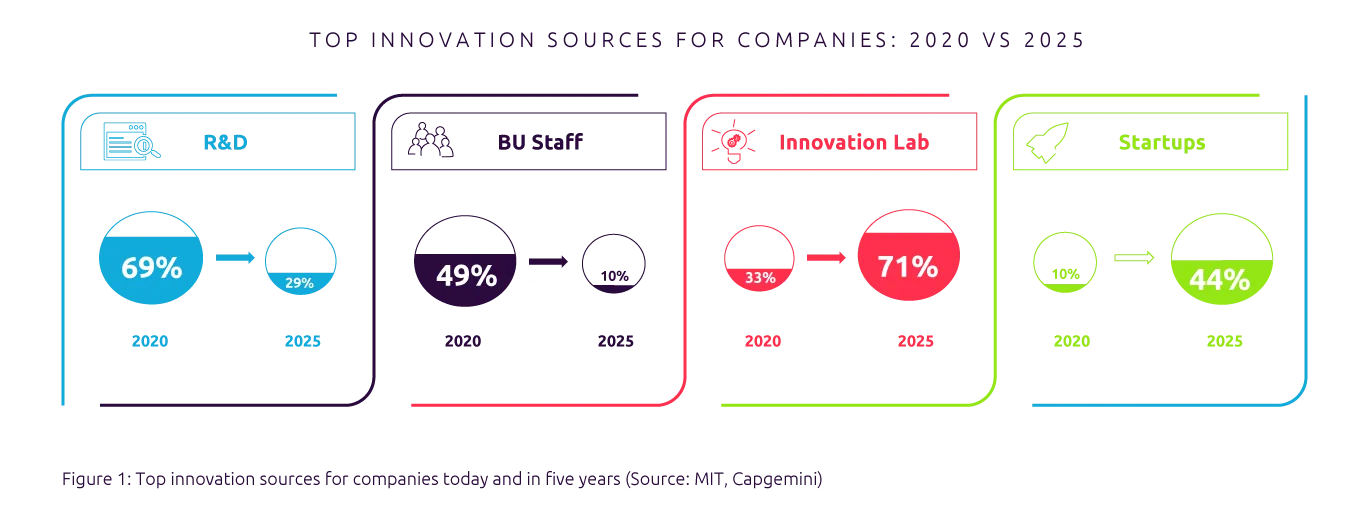The next big thing to boost your innovation – the venture client model
Blog: Capgemini CTO Blog
Key takeaways
- External and hybrid sources of innovation will become increasingly important – by 2025 startups will rank as a top innovation source for companies with great potential for sustainability.
- Venture client units are a breakthrough corporate venturing vehicle, which if operated with a specialized venture client process and with dedicated resources, enables corporations to benefit strategically from top startups.
- For corporates, the main advantage of a venture client unit is that it enables the entire organization to gain measurable competitive advantage from more and better startups – at lower risk and without any capital requirements than possible through traditional corporate venture capital programs.
- For startups, the main advantages are to quickly gain high-profile reference clients whose expert user feedback is critical to iterate and improve their products as well as through an increased valuation that results from increased traction and revenues – all without additional dilution.
Working towards a sustainable future
In today’s fast-moving world, the imperative to stay relevant forces companies to continuously reinvent themselves. New competitors transform from promising startups to unicorns in lightning speed, while rapidly shifting customer expectations and political regulations and global trends determine the market of tomorrow. Moreover, the ongoing global COVID-19 pandemic is changing our world massively, requiring companies to make the right bets today in order to secure a sustainable future.
Startups will become chief sources of innovation by 2025 – particularly focused on sustainability.
According to a joint study from MIT and Capgemini from 2020, external sources of innovation are becoming more and more important for companies. Over the next five years, startups will rank as top innovation sources for companies. Moreover, hybrid forms such as innovation labs are especially important as an interface between internal and external innovation. This is critical for companies that do not have adequate innovation capability internally and are therefore forced to source externally. As a result of this development, traditional R&D and internal business units’ employees will become less relevant as innovation sources within the next five years (see Figure 1).
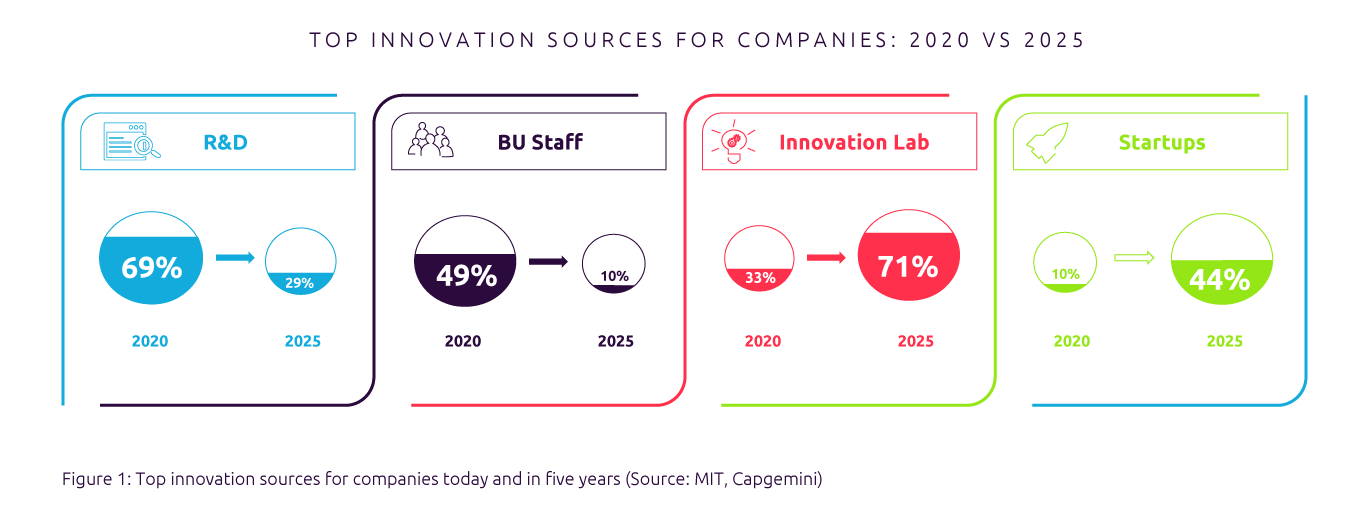
Sustainability tops the agenda of many customers and therefore of corporates. Corporates often rely on startups, which are particularly good at accelerating (digital) innovation in the area of sustainability. According to a European-wide survey by TechFounders, sustainability is a priority for around 90% of startups. Moreover, a new study found that, even though climate-tech startup investments by VCs and corporates are still low compared to overall investments, the growth rate is five times higher. For corporates, startups’ innovation potential poses a great chance to support their sustainability initiatives and targets. However, with startups gaining importance and corporates heavily focusing on sustainability, this still leaves the question “How.” How can corporations gain strategic benefits from the world’s best startups, quickly and at measurable risk?
A new model of corporate venturing has emerged.
The concept of the venture client model is new, yet simple. Instead of acquiring non-controlling equity stake, the company buys the startup product (see Figure 2). The corporate becomes, hence, a venture client rather than a venture investor with the objective to harness a strategic benefit. The strategic benefit emerges from applying the startup product to improve an existing or create a new product/service, process, business model, or even entire business. The startup solution is applied in a real business environment immediately, without being incubated or accelerated.
Obviously, to identify top startups and to buy and transfer their solutions so that they generate a measurable positive impact is highly complex. Hence, just being a venture client is not enough. The corporate needs to implement a sophisticated model, i.e., organizational venture client capabilities. Such a venture client model was first established at BMW by Gregor Gimmy (see Harvard Business Review) in 2015 with the BMW Startup Garage. Over the years, many global corporations have been following suit, including Bosch, BSH Home Appliances, LafargeHolcim, German insurer Signal Iduna. Beyond Germany, other corporations have adopted the Venture Client approach, such as the Italian energy company Enel and Spanish Telefónica.
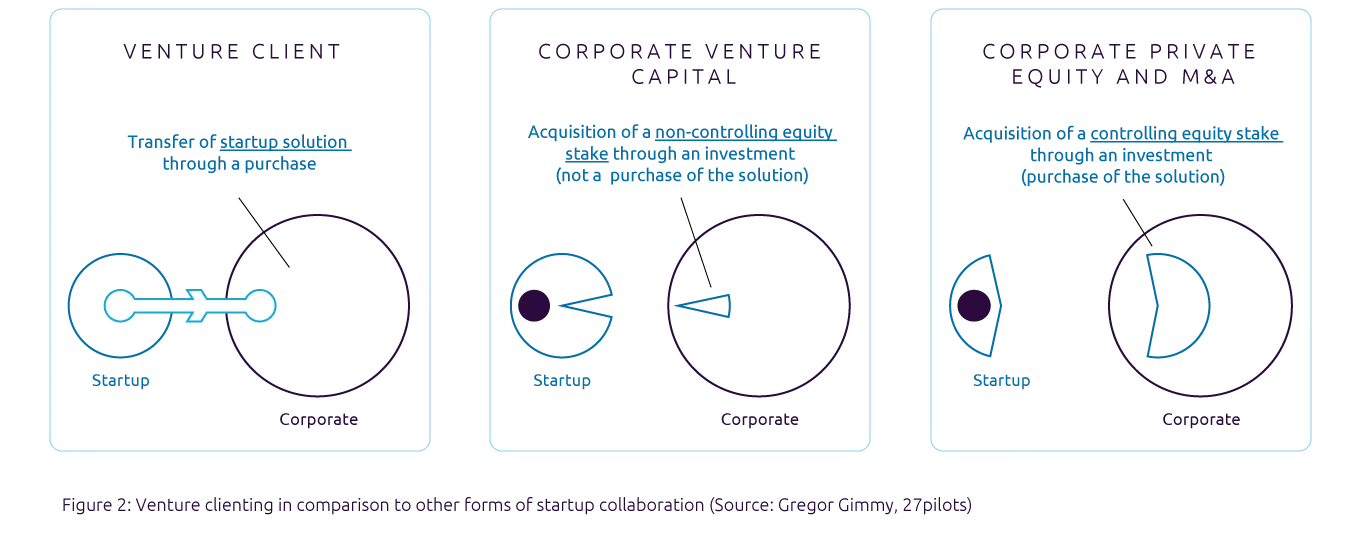
The venture client proactively solves problems
Here is an example of how a good venture client unit operates: A business unit or functional unit raises a request for support from the venture client unit to resolve a complex challenge via a startup, as it cannot solve the problem with internal or incumbent external solution providers. These challenges can be manifold (e.g., growth, efficiency) and may emerge anywhere in the company (e.g., R&D, IT, manufacturing, or logistics). The problem is strategic, as it impacts the competitiveness of the company, such as a sustainability challenge to measure CO2 emissions in real time caused by intra-factory logistics.
The venture client unit is engaged by the venture client (the factory logistics manager) to enable the whole process from identifying to adopting the best startups, like an HR department enables recruiting.
The process starts with an in-depth analysis of the challenge, to make sure that it is strategic and that startups may indeed have suitable solutions. If this is the case, the venture client unit sources for startups with relevant solutions. In our example, the venture client unit would source for startups with sensor technology, hardware and software, that detects CO2 levels inside a factory. If the problem has relevance in the startup ecosystem, as is probably the case in sustainability, the team will likely identify over 100 startups.
The venture client unit team then filters the best startups from that list. This results in five to 20 startups that are then analyzed in depth. This assessment, led by the venture client unit, involves the venture client, for example an R&D engineer or logistics manager. Once the best startup has been selected by the venture client, the company buys a small sample of the startup product. In our example, the company would buy a sample of sensors large enough to monitor CO2 levels in a small part of the factory.
The purchased products are applied in a real setting over the next two to four months. This is essential to generate real data to validate if the startup technology delivers the expected results. The data now serves to confirm if the startup solution meets the KPIs required for the last step: adoption, which is realized via partnership or M&A. The results from piloting the startup product in a real use case, are now key to enable the adoption decision.
In most cases, adoption will be a kind of partnership (e.g., licensing the startup technology). However, the venture client may also choose to acquire the whole startup, if control is a condition to generate and defend the intended competitive advantage. In addition to the just described active solving of known problems, the venture client unit also constantly looks out for strategically relevant startups to anticipate problems the corporation is unaware of. In case a top startup is detected, the venture client unit proactively contacts one or more business units that could potentially benefit from its solution. Once the relevance has been confirmed, the process as explained first, repeats itself.
The venture client model brings significant benefits for both corporates and startups (Figure 3).
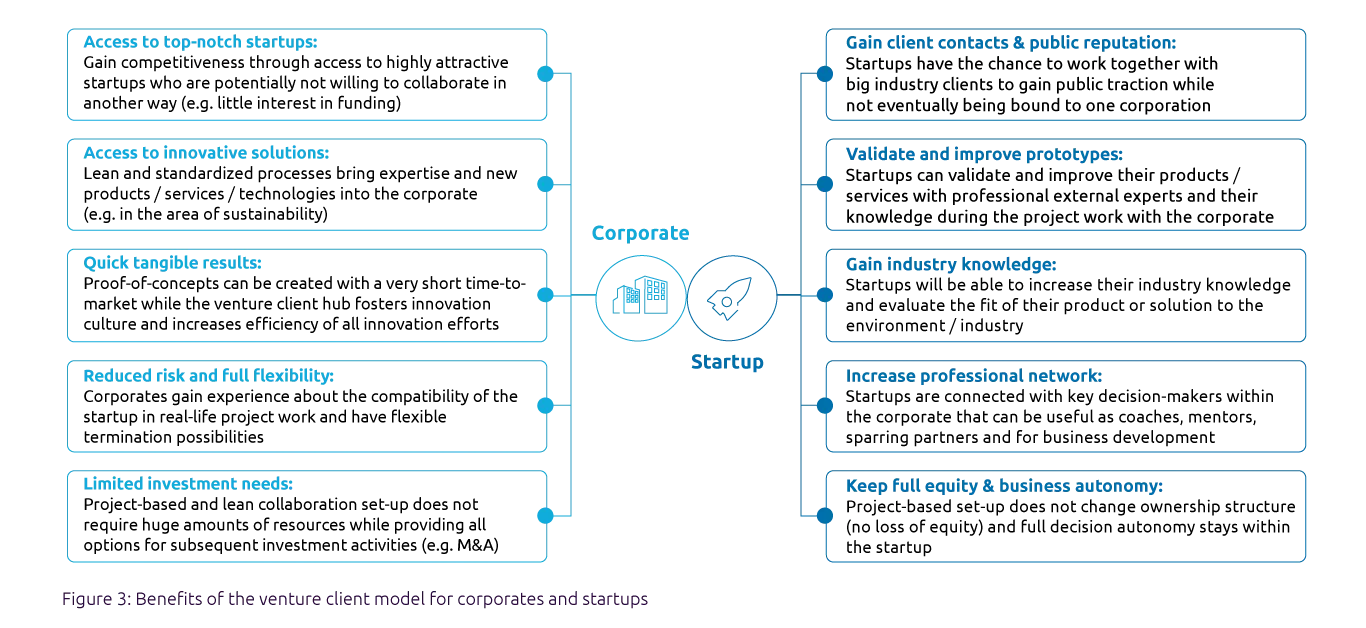
Our view on innovation and the venture client model.
At Capgemini Invent, we believe that startups are a key, but not the only solution. A state-of-the-art venture client unit with high-quality specialized processes and dedicated resources will make a big difference in enabling companies to benefit strategically from the best startups. To ultimately succeed however, most companies will have to continuously scrutinize, transform, and adopt their corporate innovation systems as such. As shown in Figure 4, our innovation operating model involves three tiers: purpose, approach, and tactics. Each tier’s components serve as gears in the innovation machine, and every one of them is an important piece of the puzzle. The venture client model has the potential to significantly influence several of these components and serve as catalyst to the whole innovation system. Our innovation experts at Capgemini Invent are more than happy to support you in establishing your venture client unit and skills. Feel free to get in touch.
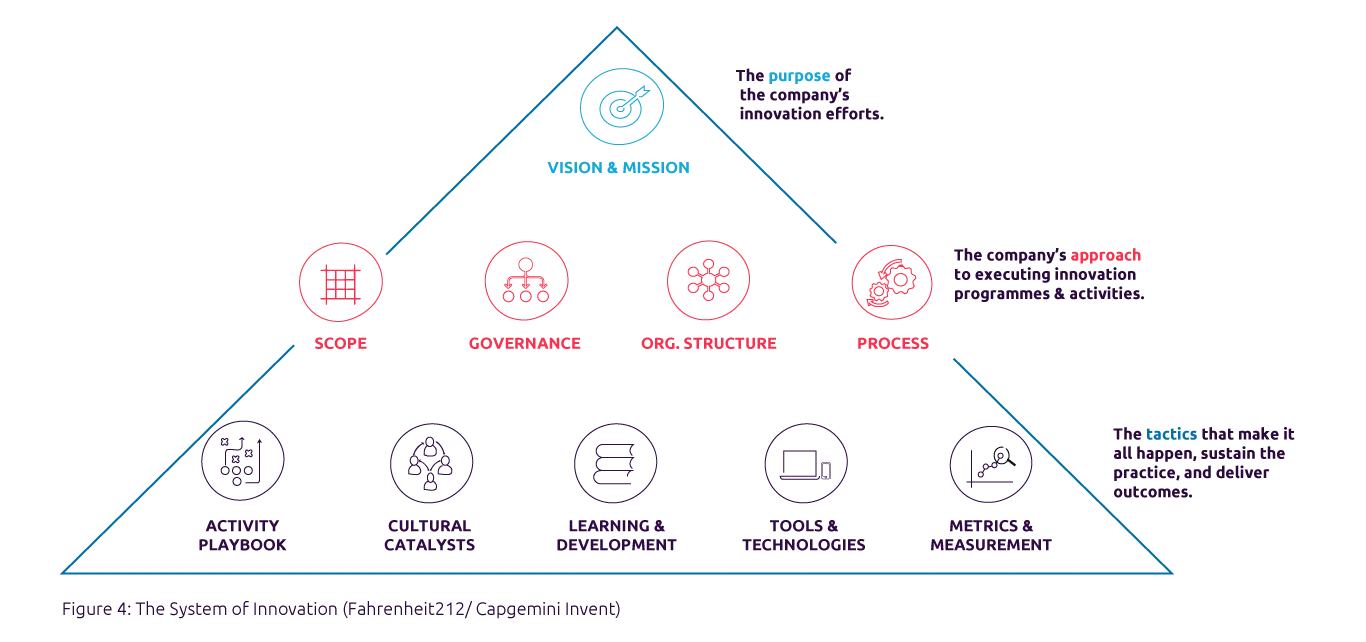
Thanks to the co-authors Manuel Wiener and Phillip Schneider.
Authors
 |
 |
 |
Jens HofmeisterHead of Central Region |
Olivier HerveVice President – Innovation and Strategy |
Kevin LoeffelbeinDirector – Smart Mobility & Business Model Innovation |
